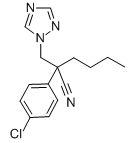Myclobutanil 腈菌唑
Introduction: Myclobutanil is a conazole class fungicide. It is used heavily to control fungi affecting wine and table grapes, especially in California. It also has a number of other food crop and commercial or residential landscaping applications. Although it has a low acute toxicity, myclobutanil has been found to affect the reproductive abilities of test animals.
Common name: Myclobutanil
Another name: Systhane; Rally; Nova (pesticide); Systhane 6 Flo; Nova W; Synthane 12E; Nu-Flow M; (+-)-Myclobutanil; Caswell No. 723K; etc.
Chemical name: (RS)-2-(4-chlorophenyl)-2-(1H-1,2,4-triazol-1-ylmethyl)hexanenitrile
Empirical formula: C15H17ClN4
Structural formula:

Mol. Weight: 288.78 g/mol
CAS No.: 88671-89-0
Specifications
Leading Myclobutanil supplier
Myclobutanil 95% TC
Myclobutanil 40% WP
Myclobutanil 12.5% EC
Packing:
BULK PACKING
Powder: 25kg/Bag, 25kg/Drum, 50kg/Drum etc.
Liquid: 200L/Drum, 20L/Drum, 10L/Drum etc.
SMALL PACKING
Powder: 1kg/Alu bag, 500g/Alu bag, 200g/Alu bag, 100g/Alu bag, 50g/Alu bag, 15g/Alu bag etc.
Liquid: 5L/Drum, 1L/Bottle, 500ml/Bottle, 250ml/Bottle, 100ml/Bottle, 50ml/Bottle etc.
Customerized packing label
Myclobutanil FAO standard
Professional registration
HAZARDS IDENTIFICATION
Hazard statement(s)
H302 (100%): Harmful if swallowed.
H319 (100%): Causes serious eye irritation.
H361 (100%): Suspected of damaging fertility or the unborn child.
H373 (41.59%): Causes damage to organs through prolonged or repeated exposure.
H411 (100%): Toxic to aquatic life with long lasting effects.
Precautionary statement(s)
P201: Obtain special instructions before use.
P202: Do not handle until all safety precautions have been read and understood.
P260: Do not breathe dust/fume/gas/mist/vapors/spray.
P231+P232: Handle under inert gas/... Protect from moisture.
P235+P410: Keep cool. Protect from sunlight.
P264: Wash ... thoroughly after handling.
P270: Do not eat, drink or smoke when using this product.
P273: Avoid release to the environment.
P280: Wear protective gloves/protective clothing/eye protection/face protection.
P281: Use personal protective equipment as required.
P301+P312: IF SWALLOWED: call a POISON CENTER/doctor/... IF you feel unwell.
P305+P351+P338: IF IN EYES: Rinse cautiously with water for several minutes. Remove contact lenses if present and easy to do - continue rinsing.
P308+P313: IF exposed or concerned: Get medical advice/attention.
P314: Get medical advice/attention if you feel unwell.
P330: Rinse mouth.
P337+P313: IF eye irritation persists: Get medical advice/attention.
P391: Collect spillage.
P405: Store locked up.
P501: Dispose of contents/container to an approved waste disposal plant.
Supplemental Hazard Statements: none.
MAMMALIAN TOXICOLOGY
Acute toxicity: 1) Acute oral LD50 for rats is >1600 mg/kg. 2) Acute dermal LD50 for rats is >5000 mg/kg. 3) Acute inhalation toxicity LC50 (4 h) for rats is >5.1 mg/L. 4) Skin irritation: Non-irritating to skin (rabbits). 5) Eye irritation: Moderately irritating to eyes (rabbits). 6) Skin sensitization for guinea pig: Not a sensitizer.
NOEL: (2 y) for rats is 2.5 mg/kg/day; (2 y) for mice is 13.7 mg/kg/day; (1 y) for dogs is 29.1 mg/kg/day. Other Not carcinogenic. Not genotoxic.
ADI (JMPR) 0-0.03 mg/kg b.w. [2014]
Classification:
WHO Classification: II (Moderately hazardous)
EC Risk Classification: Reproduction risk category 3: R63; Xn - Harmful: R22; Xi - Irritant: R36; N - Dangerous for the environment: R50, R53
US EPA Classification (formulation): No consensus across products or no products available
ECOTOXICOLOGY
Effect on birds: Acute oral LD50 for Bobwhite quail is 510 mg/kg. Effect on fish: Acute LC50 (96 h) for Rainbow trout is 2.0 mg/l. Effects on aquatic invertebrates: Acute EC50 (48 h) for Daphnia magna is 17 mg/l. Effects on algae: Acute 72 hour EC50 for Scenedemus subspicatus is 2.66 mg/l. Effects on bees: contact acute 48 hour LD50 is 33.9 μg/bee, oral acute 48 hour LD50 is >33.9 μg/bee. Effects on earthworms: Acute 14 day LC50 is 125 mg/kg.
ENVIRONMENTAL FATE
Animals In animals, undergoes oxidation at the butyl group to a ketone and an alcohol, with partial conjugation to a glucoside. Following oral administration, rapidly excreted in the faeces and urine. Plants In plants, metabolism is the same as in animals. Soil/Environment In soil, DT50 66 d (silt loam). Decomposition is through highly polar triazole compounds, with further degradation by ring splitting. No degradation under anaerobic conditions. Stable to hydrolysis, but decomposes in aqueous solutions upon exposure to light; DT50 in pond water typically 15-25 days. Low mobility in soil; Koc 224-937 ml/g.
Usage: Myclobutanil was developed by Rohm & Haas Co. (now Dow AgroSciences). It is a fungicide used to control Ascomycetes, Fungi Imperfecti and Basidiomycetes in a wide range of crops including table grapes.
Application: Biochemistry Inhibits ergosterol biosynthesis (steroid demethylation inhibitor). Mode of action Systemic fungicide with protective and curative action. Translocated upwards in the plant. Uses Control of Ascomycetes, Fungi Imperfecti, and Basidiomycetes on a wide variety of crops. The primary use is for powdery mildew (Uncinula necator) control in vines and for combined leaf scab and powdery mildew control in apples. Application rates typically 30-60 g/ha. Also registered for control of Ascomycetes or Basidiomycetes diseases on a broad variety of crops including other pome fruit, stone fruit, cucurbits, strawberries, almonds, tomatoes, vegetables, hops, cotton, cereal seed treatments, turf and ornamentals. It is used as a foliar treatment for control of powdery mildew, shot-hole, blossom blight, anthracnose and rust in stone fruit and nuts; powdery mildew in cucurbits; powdery mildew and rusts on ornamentals; rusts on perennial grasses grown for seed; and as a seed treatment for control of seed- and soil-borne diseases in barley, maize, cotton, rice and wheat; and as a post-harvest treatment in crops such as banana.
| 






